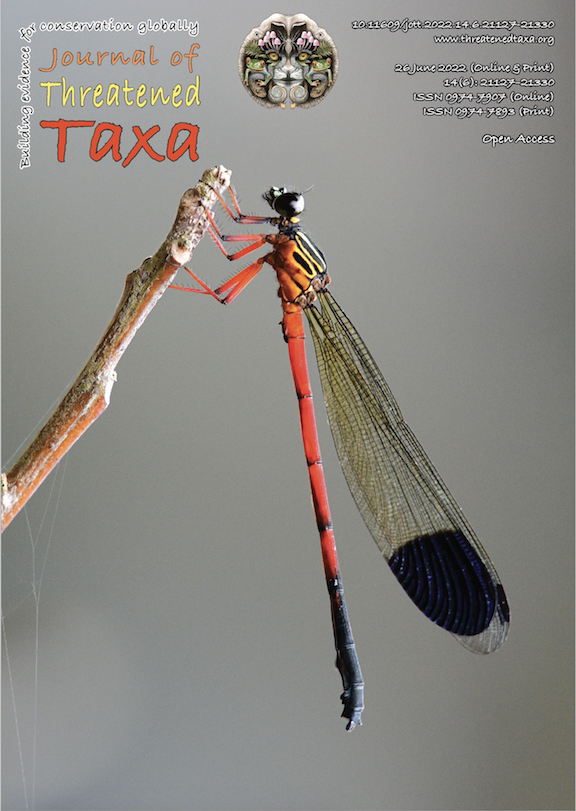Feather characteristics of Common Myna Acridotheres tristis (Passeriformes: Sturnidae) from India
Main Article Content
Abstract
The systematic study of feather microstructure supports species identification, which is important in cases of illegally traded birds and bird-aircraft strikes. Our study focused on morphometric, macro- and micro-characters of feathers of Common Myna Acridotheres tristis from India. Among macro-characters, silver-colored filoplume feathers with pale black pigmentation on the barbs are specific for A. tristis. Morphometric measurements revealed that primary contour feathers (10.8±0.100 cm) were the longest and bristle feathers (1.26±0.051 cm) the shortest among all feathers. The longest (average) barb is found in primary contour feathers (1.875±0.123 cm), and the shortest in filoplume feathers (0.288±0.017 cm). We observed 3 types of nodal structures, and elongated prongs in bristle and filoplume feathers are significant characteristics of A. tristis. These insights into feather microstructures of A. tristis will aid species identification using plumology.
Article Details

This work is licensed under a Creative Commons Attribution 4.0 International License.
Authors own the copyright to the articles published in JoTT. This is indicated explicitly in each publication. The authors grant permission to the publisher Wildlife Information Liaison Development (WILD) Society to publish the article in the Journal of Threatened Taxa. The authors recognize WILD as the original publisher, and to sell hard copies of the Journal and article to any buyer. JoTT is registered under the Creative Commons Attribution 4.0 International License (CC BY), which allows authors to retain copyright ownership. Under this license the authors allow anyone to download, cite, use the data, modify, reprint, copy and distribute provided the authors and source of publication are credited through appropriate citations (e.g., Son et al. (2016). Bats (Mammalia: Chiroptera) of the southeastern Truong Son Mountains, Quang Ngai Province, Vietnam. Journal of Threatened Taxa 8(7): 8953–8969. https://doi.org/10.11609/jott.2785.8.7.8953-8969). Users of the data do not require specific permission from the authors or the publisher.
References
Ali, S. & S.D. Ripley (1987). Handbook of the birds of India and Pakistan. Vol. 5. Oxford University Press, Bombay, 278 pp.
Ahmed, A. (1997). Live Bird Trade in Northern India. TRAFFIC India, New Delhi, 104pp.
Ahmed, A. (2001). Fraudulence in Indian live bird trade: An identification monograph for control of illegal trade. TRAFFIC India, New Delhi, 24 pp.
Ahmed A. (2013). ‘WILDLIFE ON SALE’: An insight into the Sonepur Mela, Bihar. TRAFFIC POST 17: 16.
Brom, T. (1991). The diagnostic and phylogentic significance of feather structures. PhD Thesis. Universiteit van Amsterdam, Instituutvoor Taxonomische Zoölogie, University of Amsterdam, viii+277 pp.
Chandler, A.C. (1916). A study of Feathers, with reference to their taxonomic significance. University of California Press, Berkeley, 274 pp.
Day, M.G. (1966). Identification of hair and feather remains in the gut
and faeces of stoats and weasels. Journal of Zoology 148(2): 201–
https://doi.org/10.1111/j.1469-7998.1966.tb02948.x
Dove, C.J. (1997). Quantification of Microscopic Feather Characters
Used in the Identification of North American Plovers. The Condor
(1): 47–57.
Dove, C.J. (2000). A Descriptive and Phylogenetic Analysis of Plumulaceous Feather Characters in Charadriiformes. Ornithological Monograph 51: 1–163.
Dove, C.J. & S.C. Peurach (2002). Microscopic Analysis of Feather and Hair Fragments Associated with Human Mummified Remains from Kagamil Island, Alaska. To the Aleutians and Beyond-The Anthropology of William S. Laughlin. Ethnographical Series 20: 51–62.
Dey, P., S.D. Ray, S.K. Sharma, P. Pramod & R.P. Singh (2021).Identification of a unique barb from the dorsal body contour feathers of the Indian Pitta Pitta brachyura (Aves: Passeriformes: Pittidae). Journal of Threatened Taxa 13(8): 19029–19039. https://doi.org/10.11609/jott.6362.13.8.19029-19039
Gill, F.B. (2007). Ornithology. Third Edition, W.H. Freeman and Company, New York City, 725 pp.
Kannan, R. & D.A. James (2020). Common Myna (Acridotheres tristis), version 1.0. In; Billerman, S.M. (ed.). Birds of the World. Cornell Lab of Ornithology, USA. https://doi.org/10.2173/bow.commyn.01
Lei, F.M., Y.H. Qu, Y.L. Gan, A. Gebauer & M. Kaiser (2002).The feather microstructure of Passerine sparrows in China. Journal für Ornithologie 143(2): 205–212.
Lowe, S., M. Browne, S. Boudjelas & M. De Poorter (2004). 100 of the World’s Worst Invasive Alien Species – A Selection from the Global Invasive Species Database. Invasive Species Specialist Group (Species Survival Commission) of the World Conservation Union (IUCN), 12 pp.
Lee, J., S.D. Sarre, L. Joseph & J. Robertson (2016). Microscopic characteristics of the plumulaceous feathers of Australian birds: a preliminary analysis of taxonomic discrimination for forensic purposes. Australian Journal of Forensic Sciences 48(4): 421–444. https://doi.org/10.1080/00450618.2015.107603
Lovette, I.J. & J.W. Fitzpatrick (Eds.). (2016). Handbook of Bird Biology. John Wiley & Sons, UK, 716 pp.
Robertson, J., C. Harkin & J. Govan (1984). The identification of bird feathers. Scheme for feather examination. Journal of the Forensic Science Society 24(2): 85–98. https://doi.org/10.1016/S0015-7368 (84)72301-2
Robertson, G.R. (2002). Birds of a feather stick: microscopic feather residues on stone artifacts from Deep Creek Shelter, New South Wales, pp. 175–182. Proceedings of the 2001 Australian Archaeological Assoc Annual Conference, Tempus, Anthropology Museum, The University of Queensland.
Ray, S.D., P. Dey, N. Islam, S.K.S. Sharma, P. Pramod & R.P. Singh (2021). Comparative study of Yellow-billed Babbler (Turdoides affinis) feather reveals uniformity in their microstructure among individuals. Journal of Experimental Biology and Agricultural Sciences 9(1): 51–64. https://doi.org/10.18006/2021.9(1).51.64

